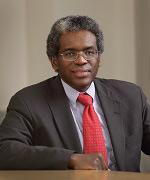
Credit: NIH
For this week’s post, I spoke with Dr. Roland Owens, Director of Research Workforce Development in the NIH Office of Intramural Research (OIR). Dr. Owens facilitates and enhances principal investigator recruitments within the Intramural Research Program. He is the OIR senior staff member responsible for promoting equity in the biomedical research workforce within the NIH.
Dr. Owens has been with the NIH since 1985 when he became a National Research Service Award Fellow in the National Institute of Child Health and Human Development. He then joined the National Institute of Diabetes and Digestive and Kidney Diseases (NIDDK) under an Intramural Research Training Award. Dr. Owens became a principal investigator in NIDDK in 1992, and he received tenure in 1998.
Among his responsibilities is the Stadtman Investigators Program, which is currently recruiting diverse, doctoral-level talent for prestigious, tenure-track positions within the NIH Intramural Research Program (IRP). My conversation with Dr. Owens covers how the Stadtman Investigators Program advances the careers of early stage investigators while enhancing diversity and inclusion in the biomedical research workforce.
Why did the NIH establish the Stadtman Investigators Program?
The NIH established the Stadtman Investigators Program in 2009, naming it for two inspiring biochemists who worked at the NIH for 50 years. The annual recruitment program enables talented early-career scientists to compete for NIH-wide tenure-track research group leader positions—the NIH equivalent of an assistant professor position.
We hold a broad search designed to attract emerging scientists who might not apply for a more traditional, narrowly defined position description at the NIH. We seek applicants from any field relevant to the NIH’s mission, but they are not required to have a specific set of skills or research focus. Instead, as part of the application process, applicants are asked to describe their research goals. If these are a good fit for the NIH, we identify a tenure-track position in one of the NIH’s Institutes or Centers that matches the applicant’s objectives. Typically, between 10 and 15 principal investigators are selected from the Stadtman search each year.
Our thirteenth annual call for Stadtman Investigators is open now through September 30. I encourage all interested doctoral-level researchers to visit the IRP website to learn more about the Stadtman Investigators Program and how to apply.
What are the benefits of being a Stadtman investigator?
As with all NIH intramural tenure-track positions, individuals selected as Stadtman Investigators receive competitive salaries, research space, resources, supported positions, and an operating budget. In addition, the IRP has facilities around the U.S., and Stadtman investigators can potentially work at any of these, depending on what is available.
The NIH has recruited more than 100 Stadtman Investigators since 2009. To date, about 25 percent of them have already become tenured senior investigators at the NIH.
What does the NIH look for in applicants?
We look for researchers who are addressing critical biomedical problems in novel ways. We also want applicants to demonstrate strategic thinking regarding their research by considering the short and long-term impacts of their work. For example, how will their research efforts influence public health over the long term? Finally, applicants should have a strong record of peer-reviewed publication—this is the NIH standard for principal investigators who lead laboratories.
How does the program enhance diversity and inclusion in the biomedical research workforce?
Diversity and inclusion are at the core of the Stadtman Investigators Program. Over the last 12 years, this program has helped the NIH successfully identify and recruit from a diverse talent pool. Our metrics demonstrate that this type of broad search for investigators across all areas of biomedical research—in comparison to more narrow, Institute-centered searches—is a strategy that can enhance diversity in the scientific workforce.
The IRP aims to foster an inclusive environment that leverages diverse talent to advance health discovery. Thus, a key part of our mission is recruiting a wide range of creative thinkers eager to take on innovative, high-impact research, both through the Stadtman Investigators Program and other initiatives.
Dr. Bernard’s Parting Thoughts:
The Stadtman Investigators Program is both an exceptional opportunity for emerging scientists to join the IRP and a new paradigm of inclusive excellence at the NIH. I hope Dr. Owens has inspired eligible readers to consider applying for a Stadtman Investigator position. I look forward to welcoming this next cohort of talented researchers to the NIH.

